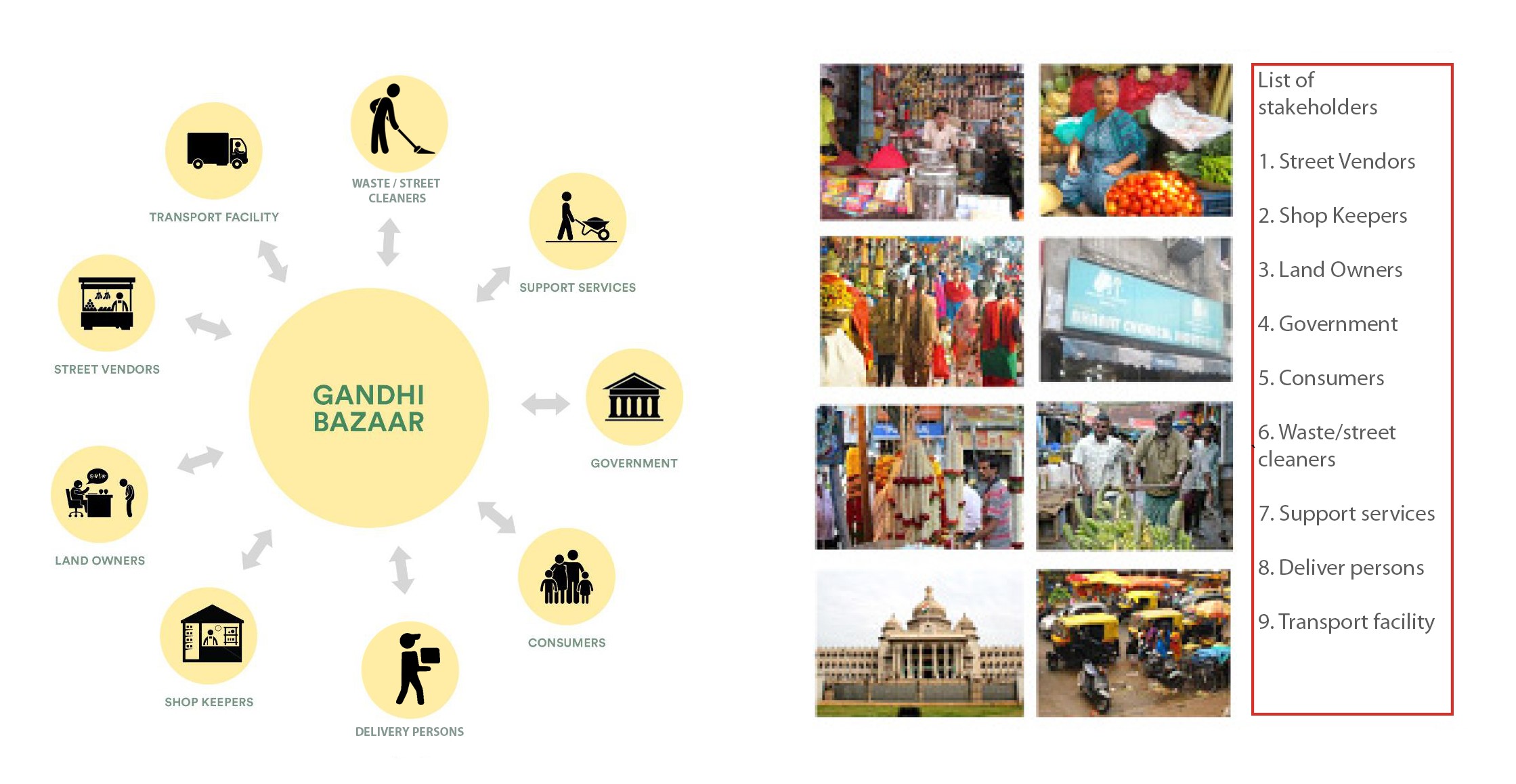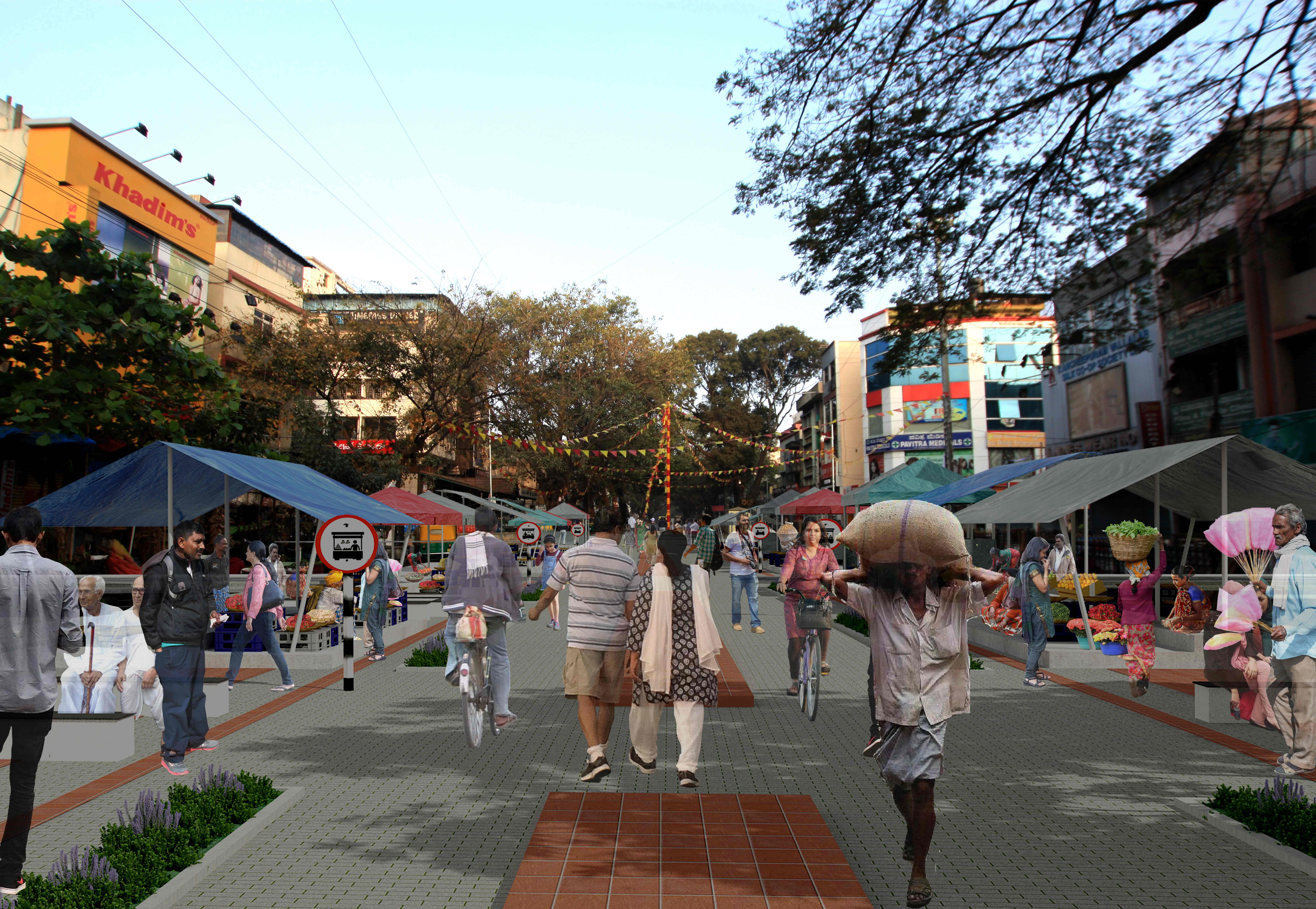

Designing an inclusive street market for the historic Gandhi Bazaar through a participatory design process
Gandhi Bazaar is a street full of life, engaging a variety of people, and home to numerous restaurants, shops, banks and office. Gandhi Bazaar Main Road is about 700m long. Gandhi Bazaar street market functions throughout the year and provides a setting for numerous lives and livelihoods. Located in the planned residential neighbourhood of Basavanagudi (established in 1898) in the southern part of Bengaluru, Gandhi Bazaar is lined with retail shops, restaurants, banks, offices and other commercial uses. Informal vending of fruits, flowers and vegetables along this street started about 80-100 years ago. Over time it has matured into a full-fledged street market, supporting both formal and informal retail. The Street Market is now congested and poorly managed. The street is clogged with vehicular traffic and the narrow footpaths congested with vendors and pedestrians. The solid waste management is not supported with appropriate design and planning. The informal, historic and diverse use / culture of the street needs a new understanding and sensitive design that will be inclusive and participatory.
Aim: The spatial infrastructure plan for Gandhi Bazaar Main Road and the Gandhi Bazaar street market is prepared with the aim to enhance it as a vibrant and inclusive Socio-cultural space, while making it economically efficient, safe, accessible, clean, green and comfortable for all users. The design framework will be inclusive, flexible and anticipatory of future changes and the diverse needs of various actors in the market street, and be financially viable. It will ensure compliance with all applicable local, state and national laws having spatial implications. Short-term and long-term solutions will be proposed for its implementation and it will serve as a prototype that will demonstrate how other markets can create similar frameworkssuited to their unique context.
Objectives - a)To develop a spatial infrastructure design that provides an approach and a framework for improving the physical, social and health conditions of Gandhi Bazaar Street Market and Main Road, through a participatory planning process b)To prepare detailed project reports and terms of reference to implement the plan
The scope of the spatial planning project is to plan and design the spatial infrastructure for Gandhi Bazaar Street Market and Gandhi Bazaar Main Road with an emphasis on the fruit and vegetable market. This includes the following activities: • Preparation of a public participatory process in coordination with DULT and the Management consultants to engage with the necessary stakeholders; • Preparation of three design scenarios through a public participatory process including consultations with the necessary government agencies as well as other stakeholders; and • Develop a preferred design scenario with the approval of all government agencies and stakeholders; • Prepare a Detailed Project Report (DPR) and Terms of Reference (ToR) along with identification of sub-projects in order of priority to plan for finances to implement them. The proposals recommending an operations and management strategy for implementing the Street Vendors Act, and the spatial plan proposals arenot within the scope of this project. This has been undertaken as a separate consultancy with ESG commissioned by GIZ.

The Urban Design Strategy Gandhi Bazaar Street Market is a local and city level destination for a variety of activities and goods. The rich cultural heritage, variety in building uses & institutions, parks, play grounds, schools, colleges, hospitals, and other commercial buildings, greenery (street trees and large parks) contribute to a rich and diverse character of place. Strategies at a larger scale were developed to conserve the cultural landscape and heritage; 1. Encourage walking and gathering for social interaction and enhancing business opportunities 2. Minimise vehicular traffic to create pollution free and safe environment for people. 3. Link to activity generators, major landmarks and public amenities and institutions. 4. Connect existing retail and vending activity areas. 5. Make access safe and conventient by providing alternate modes of transport including bicycles and electric vehicles. 6. Provide access to two-wheeler and car parking at walkable distances from shopping and work areas.

Street section of the preferred scenario
The following urban design guidelines will help implement the urban design strategies and vision. These guidelines relate to both the spatial design and management strategies for street markets. The design principles are indicated in BOLD. 1. Promote DIVERSITY of functions and uses and maintain street VITALITY to attract various user groups to the street market. 2. Sustain INFORMALITY of street activities to enhance diversity and richness in public life. 3. Nurture a SENSE OF COLLECTIVE MEMORY to recognize the historicity of the place and its heritage values 4. Strengthen the ROBUSTNESS and ADAPTABILITY of the place to ensure long term sustenance and economic viability. 5. Enhance IMAGEABILITY of the street market to give it a distinct character and image 6. Promote INCLUSIVENESS and GENDER SENSITIVITY to make it an active public commons 7. Ensure ACCESSIBILITY to all parts of the street to encourage different users to experience the market. 8. Ensure SAFETY and SECURITY of all users.

The Recommended Street Design is based on the studies undertaken, the input of the public obtained through the public participatory process and interactions with government agencies, the consultant team recommended the design shown above with the following key strategies: 1. Link the two parks (Ramakrishna Ashram Circle Park and Tagore Park), which today are mere traffic islands, to the Bazaar street and its activities. 2. Enhance the pedestrian environment and create a safe, clean, green and active pedestrian walkway from the Flower market building to Karanji Anjaneya Circle. 3. Activate the edges of the buildings and shops to encourage street activity and enhance the shopping experience. 4. Introduce outdoor spaces for social interaction, seating, and cultural events at places such as eateries, restaurants and where people gather on the street. 5. Restrict traffic and vehicular functions such as parking for autos and vehicles to intersections and selected areas to maintain a pollution free walking environment. 6. Facilitate accessibility to shops, restaurants, offices and other services by providing two and four wheeler parking within walking distance.

Preferred scenario - Gandhi Bazaar Circle

Preferred scenario - Towards Ram Krishna Ashram Circle
